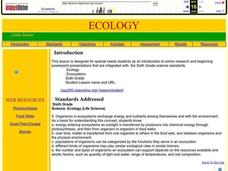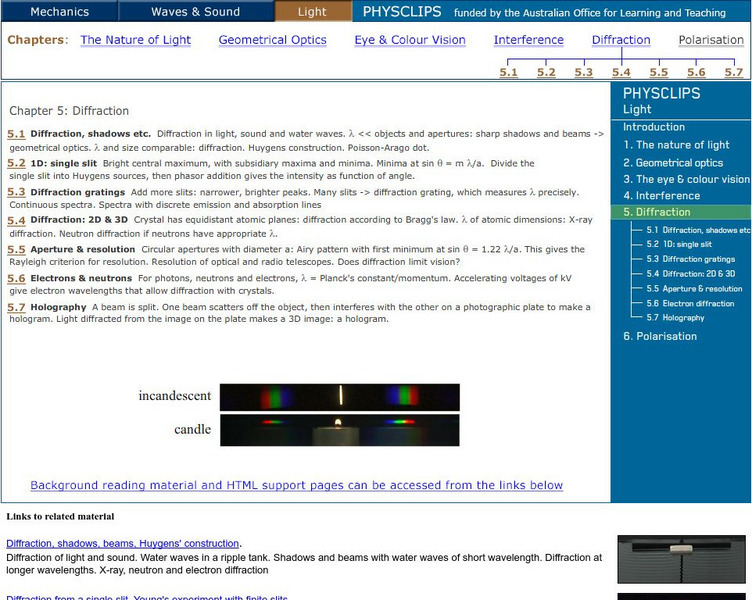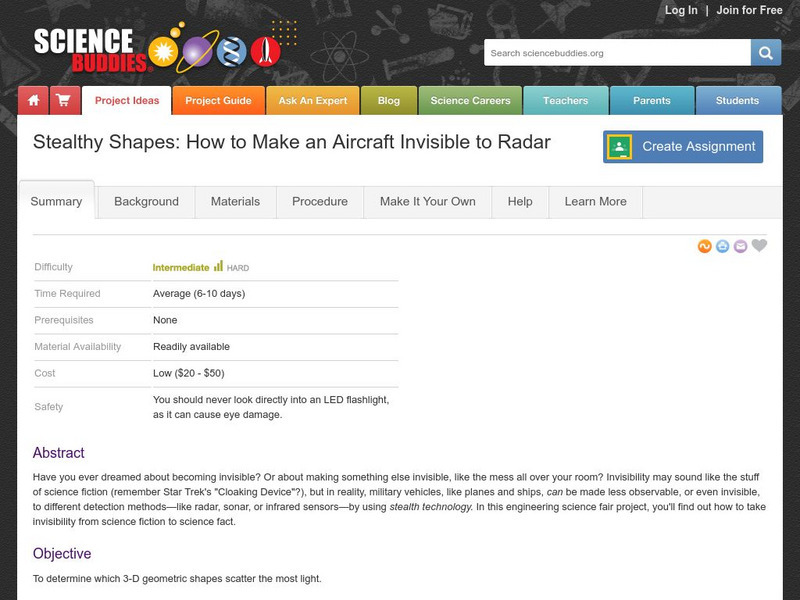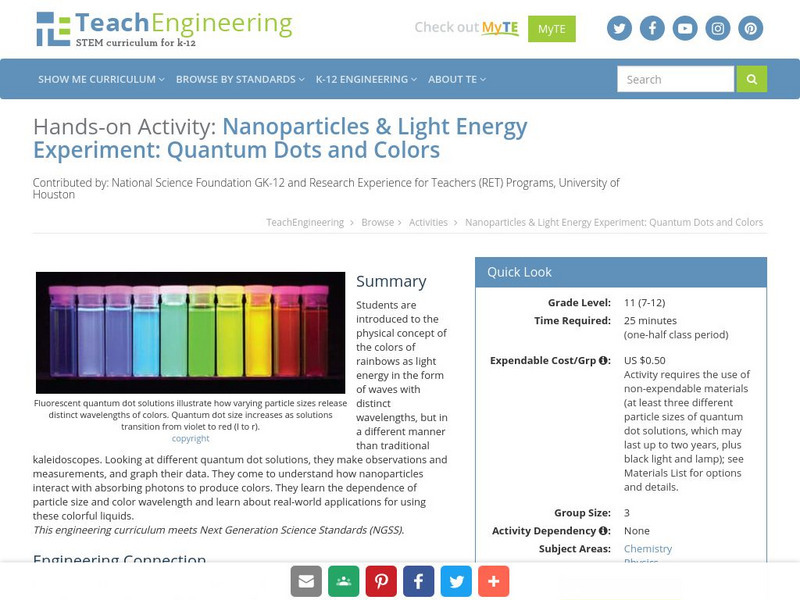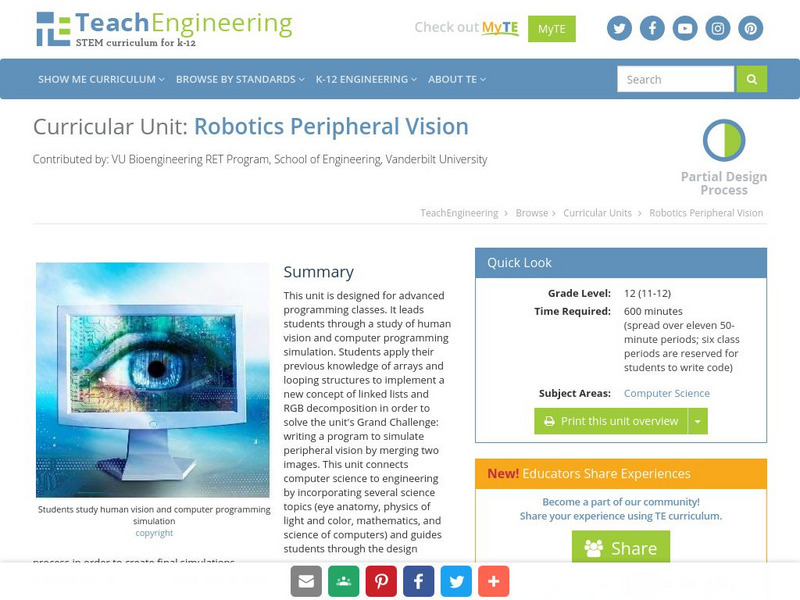Curated OER
Ecology
Sixth graders are introduced to online research and beginning PowerPoint presentations that are integrated. They pass a plant and photosynthesis. Students locate information on a self selected animal online. They give a PowerPoint...
University of New South Wales (Australia)
University of New South Wales: School of Physics: Physclips:the Nature of Light
Physiclips thoroughly presents mechanics concepts about light with animations and film clips. Learn about light and color, wavelengths, speed of light, electromagnetic waves, Young's experiment, and photons.
Georgia State University
Georgia State University: Hyper Physics: Scattering Concepts
A collection of several pages explaining the principles which underlie Rayleigh scattering of light.
University of New South Wales (Australia)
University of New South Wales: School of Physics: Physclips: Geometrical Optics
Physiclips thoroughly presents geometrical optics concepts like rays, refraction, Snell's law, total internal reflection, dispersion, mirrors, and lenses with animations and film clips.
University of New South Wales (Australia)
University of New South Wales: School of Physics: Physclips: Diffraction
Physiclips thoroughly presents the concept of diffraction with animations and film clips.
CK-12 Foundation
Ck 12: Physics: Wave Optics Study Guide
A study guide for concepts related to wave optics.
Open Curriculum
Open Curriculum: The Ray Model of Light
Students will understand the concept of the ray model of light and how light interacts with matter and reflections.
CK-12 Foundation
Ck 12: Physical Science for Middle School
This digital textbook covers core physical science concepts and includes interactive features, real world examples, and videos.
Physics Classroom
The Physics Classroom: Refraction/ray Model of Light: The Angle of Refraction
Focusing on the question, "By how much does light refract when it crosses a boundary?" this physics tutorial will allow students the opportunity to explore these concepts of refraction.
Physics Classroom
The Physics Classroom: Refraction and Ray Model of Light: The Critical Angle
Illustrated examples and interactive practice problems that introduce students to the concept of the critical angle, the angle of incidence that provides an angle of refraction of 90-degrees.
Physics Classroom
The Physics Classroom: Waves: Waves and Wavelike Motion
Here is an introduction to the concept of waves and wavelike motion people experience anywhere and everywhere.
Physics Classroom
The Physics Classroom: Refraction and the Ray Model of Light: Anatomy of the Eye
This tutorial looks at the anatomy of the eye and how the sense of sight works. This is the first part of a learning module. Subsequent sections cover how images are formed and detected, the concept of accommodation where the eye adjusts...
Georgia State University
Georgia State University: Hyper Physics: Atmospheric Optics Concepts
This physics department site features an indexing page for a variety of pages pertaining to atmospheric optics. Topics include rainbows, halos, auroras, mirages, star twinkling, sunsets, green flashes, coronas, and more. Excellent...
Symmetry Magazine
Symmetry Magazine: Explain It in 60 Seconds: Cherenkov Light
Cherenkov light is explained here as the light emitted when a charged particle travels through matter faster than light would be able to. This would be slower, however, than the maximum speed of light, which occurs in a vacuum. "Explain...
University of Colorado
University of Colorado: Physics 2000: Lasers
If you want to know how atoms and photons work together to make lasers this site has great explanations. There are interactive applets to help you really understand the concepts!
Science Buddies
Science Buddies: Project Ideas: How to Make an Aircraft Invisible to Radar
In this engineering science fair project, students will determine which 3-D geometric shapes scatter light the most. The Science Buddies project ideas are set up consistently beginning with an abstract, objective, and introduction,...
BBC
Bbc: Bitesize: Gcse: Physics: Reflection and Refraction
All waves will reflect and refract in the right circumstances. The reflection and refraction of light explain how people see images, color and even optical illusions. This tutorial discusses each concept and presents an experiment to try...
Symmetry Magazine
Symmetry Magazine: Explain It in 60 Seconds: Light Sources
Light sources are usually synchrotrons, accelerators that are used to produce intense light beams for research purposes. "Explain It In 60 Seconds" is an article series that aims to summarize in a few paragraphs the meaning of different...
TeachEngineering
Teach Engineering: Quantum Dots and Colors
Students are introduced to the physical concept of the colors of rainbows as light energy in the form of waves with distinct wavelengths, but in a different manner than traditional kaleidoscopes. Looking at different quantum dot...
Physics4kids
Physics 4 Kids: Light Overview Quiz
Take this ten question multiple choice quiz on the main concepts of light.
Science Buddies
Science Buddies: Project Ideas: How Primary Colors Combine to Make New Colors
In this science fair project, paint color pie slices onto a wheel and spin the wheel on an electric drill. See how colors add together to make new colors. The Science Buddies project ideas are set up consistently beginning with an...
Wikimedia
Wikipedia: The Black Hole
This site examines the black hole as an object in astrophysics. Delve into this comprehensive resource that covers this concept from its history, to qualitative physics, the reality of black holes, mathematical physics and more.
Open Curriculum
Open Curriculum: Refraction
Students can study this article to help them understand the concept of refraction and index of refraction.
TeachEngineering
Teach Engineering: Robotics Peripheral Vision
This unit is designed for advanced programming classes. It leads students through a study of human vision and computer programming simulation. Students apply their previous knowledge of arrays and looping structures to implement a new...


